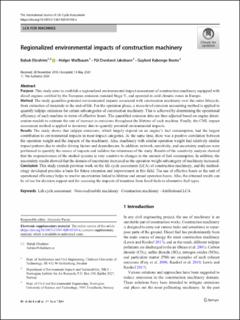| dc.contributor.author | Ebrahimi, Babak | |
| dc.contributor.author | Wallbaum, Holger | |
| dc.contributor.author | Jakobsen, Pål Drevland | |
| dc.contributor.author | Booto, Gaylord Kabongo | |
| dc.date.accessioned | 2020-08-14T07:08:23Z | |
| dc.date.available | 2020-08-14T07:08:23Z | |
| dc.date.created | 2020-07-02T14:43:42Z | |
| dc.date.issued | 2020 | |
| dc.identifier.citation | The International Journal of Life Cycle Assessment. 2020, 25, 1472-1485. | en_US |
| dc.identifier.issn | 0948-3349 | |
| dc.identifier.uri | https://hdl.handle.net/11250/2671944 | |
| dc.description.abstract | PURPOSE: This study aims to establish a regionalized environmental impact assessment of construction machinery equipped with diesel engines certified by the European emission standard Stage V, and operated in cold climatic zones in Europe. METHOD: The study quantifies potential environmental impacts associated with construction machinery over the entire lifecycle, from extraction of materials to the end-of-life. For the operation phase, a meso-level emission accounting method is applied to quantify tailpipe emissions for certain subcategories of construction machinery. This is achieved by determining the operational efficiency of each machine in terms of effective hours. The quantified emission data are then adjusted based on engine deterioration models to estimate the rate of increase in emissions throughout the lifetime of each machine. Finally, the CML impact assessment method is applied to inventory data to quantify potential environmental impacts. RESULTS: The study shows that tailpipe emissions, which largely depend on an engine’s fuel consumption, had the largest contribution to environmental impacts in most impact categories. At the same time, there was a positive correlation between the operation weight and the impacts of the machinery. Also, machinery with similar operation weight had relatively similar impact patterns due to similar driving factors and dependencies. In addition, network, sensitivity, and uncertainty analyses were performed to quantify the source of impacts and validate the robustness of the study. Results of the sensitivity analysis showed that the responsiveness of the studied systems is very sensitive to changes in the amount of fuel consumption. In addition, the uncertainty results showed that the domain of uncertainty increased as the operation weight subcategory of machinery increased. CONCLUSION: This study extends previous work on the life cycle assessment (LCA) of construction machinery, and the methodology developed provides a basis for future extension and improvement in this field. The use of effective hours as the unit of operational efficiency helps to resolve uncertainties linked to lifetime and annual operation hours. Also, the obtained results can be of use for decision support and for assessing the impacts of transition from fossil fuels to alternative fuel types. | en_US |
| dc.language.iso | eng | en_US |
| dc.rights | Navngivelse 4.0 Internasjonal | * |
| dc.rights.uri | http://creativecommons.org/licenses/by/4.0/deed.no | * |
| dc.title | Regionalized environmental impacts of construction machinery | en_US |
| dc.type | Peer reviewed | en_US |
| dc.type | Journal article | en_US |
| dc.description.version | publishedVersion | en_US |
| dc.rights.holder | © The Author(s) 2020 | en_US |
| dc.source.pagenumber | 1472-1485 | en_US |
| dc.source.volume | 25 | en_US |
| dc.source.journal | The International Journal of Life Cycle Assessment | en_US |
| dc.identifier.doi | 10.1007/s11367-020-01769-x | |
| dc.identifier.cristin | 1818314 | |
| dc.relation.project | Statens Vegvesen: * | en_US |
| cristin.ispublished | true | |
| cristin.fulltext | original | |
| cristin.qualitycode | 2 | |

